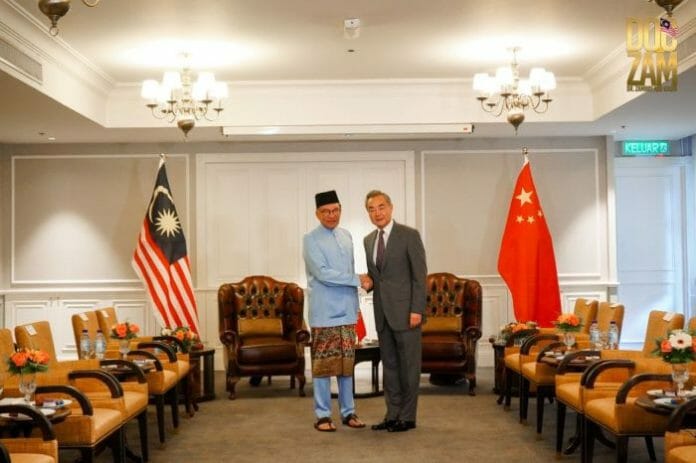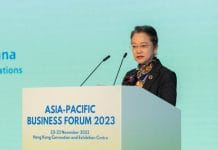Foreign Minister Wang Yi’s travel to a three-country strategic engagement stint is aimed at shoring up public and diplomatic image of the country, deepening trust and strategic mutual dependence, and regaining soft power and geopolitical influence in the region amidst growing tension with the US and worsening tension in the South China Sea against the backdrop of the water cannoning incident with the Philippines.
The trip to Cambodia, Malaysia, and Singapore is a focused approach to ensuring that security and economic returns to Beijing are maintained. ASEAN has been China’s biggest trading partner since 2020. Singapore, Malaysia, and Cambodia were among the top targets for Chinese Belt and Road engagement in the past two years, according to data from Fudan University’s Green Finance and Development Centre.
China is now facing one of its most serious internal economic downturns and weakening prospects of post-pandemic recovery. It faces the brunt of the West’s technology and critical sectors’ embargo, and the growing inefficacy of its dual circulation economic strategy and its own version of friendshoring with the Global South, BRICS, and the de-dollarisation movement has created a new scramble to shore up regional support and trust.
Beijing’s latest economic and trade data reflects the growing futility of its pushback against the West’s economic containment in a comprehensive economic, energy, and technology encirclement. Beijing would try to ensure economic integration in the region was not undermined and dictated by the United States, and that its economic influence will still prevent the overtures of the West in this region.
Beijing realises the rising intensity of collective Western pushback on its manouvres in the South China Sea, Taiwan Strait, Indian Ocean, and the Pacific Islands in Beijing’s scramble to reassert its lost momentum in recent years amidst growing containment pushback as seen in the expansion of Quad’s collectivised hard power activities, AUKUS’ expanded efficacy through potential future usage of Australia’s vast geographical territory as testing ground for hypersonic missiles in countering Beijing’s growing threat, including the Malabar exercise involving all four Quad members that have just begun in Australia.
The trip to Singapore and Malaysia will be crucial in providing assurances of Beijing’s commitment to the stability and peace of the region amidst the growing tensions. Beijing realises the criticality of both Singapore and KL in ensuring their long term support for Beijing’s regional role and leadership including the legitimacy and soft power commitment to providing economic and development security through Beijing’s leadership in BRI and RCEP.
Beijing is cognisant of both Malaysia and Singapore’s wariness on its increasing hard power postures in the region, which might push both to seek closer defence and security ties and affiliation with the US and the West either through enhancement of bilateral defence partnerships or in strengthening current or exploring new multilateral security partnerships including FPDA or the expansion of Quad and the creation of AUKUS friendly joint training and support initiative.
Any new fears triggered by Beijing’s actions might derail the dependence and postures of both countries on China, especially when the competition for both countries’ strategic geopolitical and geostrategic assets has intensified.
From rare-earth to food security and semiconductor and supply chain resilience, both remain complementary factors in completing the full circle of a total defence and security architecture, with Singapore being seen as having the greater risk of being more inclined to switch to a full alignment with the US.
With Singapore being the most affiliated with the US in terms of military presence and the long-held dependence on the US for its security assurances, Singapore is high on the priority list for Beijing in engaging in more strategic trust-building. This is coupled with Singapore’s less reliance on China for its economic importance as compared to Malaysia and Cambodia, and its growing role in the regional security architecture that might hamper Beijing’s hard power postures and calculations, especially when the prospects of an expansive partnership with external defence platforms and with individual regional players, especially Jakarta and Manila.
Singapore serves as a vital support and supply point for any potential full-blown conflict in South China Sea or Taiwan, in serving as the chain in better connecting the AUKUS submarine capacity through the Java Sea and through critical chokepoints including the Sunda and Lombok Straits. The AUKUS base in Perth will provide a shorter response time for the West, and better serve a two-pronged high-intensity conflict in both the Indian Ocean and South China Sea which will strengthen the collective and integrated maritime interoperability of both the Quad and AUKUS partners.
Singapore remains the vital platform for the US in its Freedom of Navigation (FON) exercises in the South China Sea and Taiwan Strait. Singapore took on the logistical support role for US forces in the Western Pacific just as the Subic Bay Naval Base and Clark Air Base in the Philippines were being shut down since the 1990s.
The city-state also complements the strategic returns of the renewed expansion of the Enhanced Defense Cooperation Agreement (EDCA) with Washington will see the strategic presence of US power in the most direct counterbalancing locations to Beijing’s intent in the region. The 1951 Mutual Defence Treaty with the US remains the pinnacle of Manila’s security fallback.
The Camilo Osias navy base in Sta Ana and Lal-lo airport, both in Cagayan province, and Camp Melchor Dela Cruz in Gamu, Isabela province, and the island of Balabac off Palawan, provide Manila with the much-needed hard power boost and also strengthen America’s second front capacity in case of a Taiwanese invasion and providing needed support for Seoul and Tokyo.
Singapore acts as the containment of the domino effect in acting both as a barrier against potential Chinese submarine warfare capacity and in serving as the support base for the potential blockade of Malacca Strait in wartime.
The same support is needed for both the critical chokepoints of the Lombok and Sunda Straits and in providing cover for Northern Australia.In wartime, Chinese submarines will have alternatives through the Sunda Strait or Lombok Strait. One advantage over the Malacca Strait, is that both would deliver the submarines to the deep water of the eastern Indian Ocean.
The Sunda Strait would be the shortest route, but it is shallow and the deeper Lombok Strait might be preferred. Singapore will be of strategic support in helping a potential blockade of Malacca Strait in cutting off access for Chinese submarines in wartime, and forcing the usage of Lombok Strait which will give the West more opening and time support in containing Beijing’s capacity. Conventional Chinese submarines are noisier, which makes them more vulnerable to detection but still possess a natural stealth advantage.
Once through into the Indian Ocean, the Chinese submarines could get resupplied without having to return to China, using its base in Djibouti on the Horn of Africa and also potential new openings in Sri Lanka and the Gwaddar port in Pakistan. Gwaddar has an added advantage by being connected by land to China, which ensures that supplies would not have to go by sea.
Singapore thus remains critical for Beijing, and it cannot afford to slip down the path of greater US military presence.
The 2019 renewal of a three-decade-old pact between the US and Singapore that grants US forces access to the Lion City’s naval and air bases portrays the country’s importance, especially in serving as the connecting point for the West’s maritime extended strategy from the Indian Ocean to the Pacific in running through the South China Sea.
Under the renewed agreement, the US will have access to Singapore’s naval and air base facilities until 2035. The first renewal of the pact in 2005 granted the US access to the facilities until 2020.
US Navy ships including nuclear submarines and aircraft carrier groups are frequent visitors to the city state’s Changi Naval Base – which serves as a refuelling and resupply point for American forces in the Western Pacific.
For Cambodia, Beijing will seek to reaffirm an already ingrained strong partnership, and the core essence of that will be the upcoming Ream base. Phnom Penh will need to maintain robust economic dependence on Beijing, and it remains the bulwark of Beijing’s symbol of dominance in continental Southeast Asia.
The Ream base offers greater room for Beijing in the wider region of the Gulf of Thailand, where the Ream base is expanding in its reach and posing a threat to both Thailand and Vietnam and other archipelago states of the region in the domain of the South China Sea dispute.
The region remains critical for Beijing in its larger power postures in the Pacific, Indian Ocean, and Australasia, and it remains the centre of a growing powder keg that will make or break Beijing’s regional and global ambitions. The momentum of the West’s de-risking and friendshoring efforts has now turned the tide against Beijing’s steady progress on shoring up its support, and this region is the key platform for its Taiwan ambition and its long-term 2049 Rejuvenation Dream that seeks to challenge the US and replacing it as the global military and economic superpower in a new China centric order. Thus, a new scramble and urgency to reaffirm both hearts and minds and in having the fallback of persistent hard power capacity for both carrot and stick approach remains pertinent for Beijing.
By COLLINS CHONG YEW KEAT, Foreign Affairs and Security Strategist UNIVERSITI MALAYA









